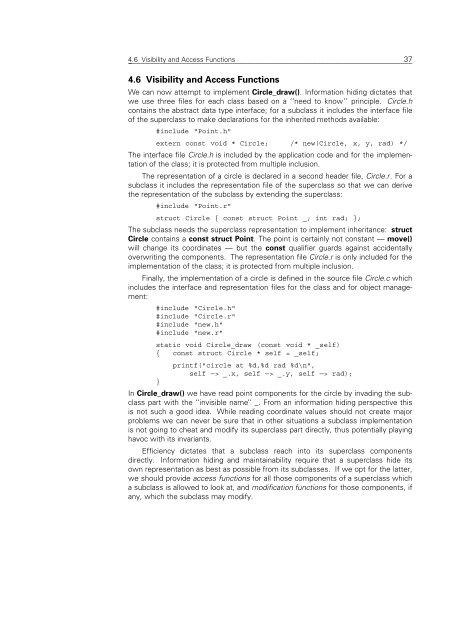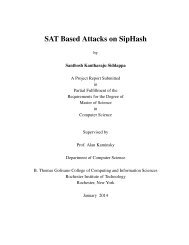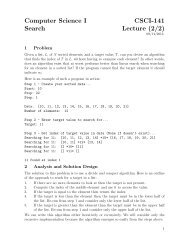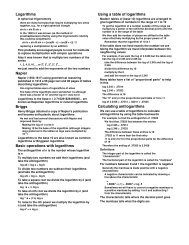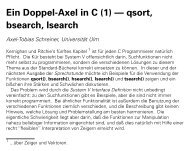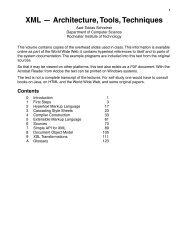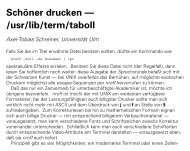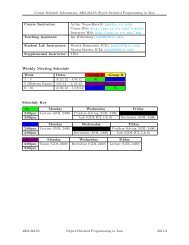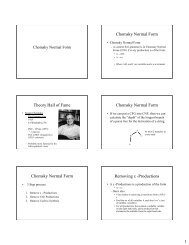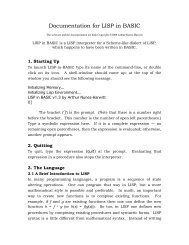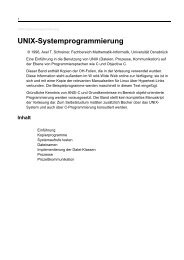Object-Oriented Programming With ANSI-C (pdf)
Object-Oriented Programming With ANSI-C (pdf)
Object-Oriented Programming With ANSI-C (pdf)
Create successful ePaper yourself
Turn your PDF publications into a flip-book with our unique Google optimized e-Paper software.
4.6 __________________________________________________________________________<br />
Visibility and Access Functions<br />
37<br />
4.6 Visibility and Access Functions<br />
We can now attempt to implement Circle_draw(). Information hiding dictates that<br />
we use three files for each class based on a ‘‘need to know’’ principle. Circle.h<br />
contains the abstract data type interface; for a subclass it includes the interface file<br />
of the superclass to make declarations for the inherited methods available:<br />
#include "Point.h"<br />
extern const void * Circle; /* new(Circle, x, y, rad) */<br />
The interface file Circle.h is included by the application code and for the implementation<br />
of the class; it is protected from multiple inclusion.<br />
The representation of a circle is declared in a second header file, Circle.r. Fora<br />
subclass it includes the representation file of the superclass so that we can derive<br />
the representation of the subclass by extending the superclass:<br />
#include "Point.r"<br />
struct Circle { const struct Point _; int rad; };<br />
The subclass needs the superclass representation to implement inheritance: struct<br />
Circle contains a const struct Point. The point is certainly not constant — move()<br />
will change its coordinates — but the const qualifier guards against accidentally<br />
overwriting the components. The representation file Circle.r is only included for the<br />
implementation of the class; it is protected from multiple inclusion.<br />
Finally, the implementation of a circle is defined in the source file Circle.c which<br />
includes the interface and representation files for the class and for object management:<br />
#include "Circle.h"<br />
#include "Circle.r"<br />
#include "new.h"<br />
#include "new.r"<br />
static void Circle_draw (const void * _self)<br />
{ const struct Circle * self = _self;<br />
printf("circle at %d,%d rad %d\n",<br />
self —> _.x, self —> _.y, self —> rad);<br />
}<br />
In Circle_draw() we have read point components for the circle by invading the subclass<br />
part with the ‘‘invisible name’’ _. From an information hiding perspective this<br />
is not such a good idea. While reading coordinate values should not create major<br />
problems we can never be sure that in other situations a subclass implementation<br />
is not going to cheat and modify its superclass part directly, thus potentially playing<br />
havoc with its invariants.<br />
Efficiency dictates that a subclass reach into its superclass components<br />
directly. Information hiding and maintainability require that a superclass hide its<br />
own representation as best as possible from its subclasses. If we opt for the latter,<br />
we should provide access functions for all those components of a superclass which<br />
a subclass is allowed to look at, and modification functions for those components, if<br />
any, which the subclass may modify.


